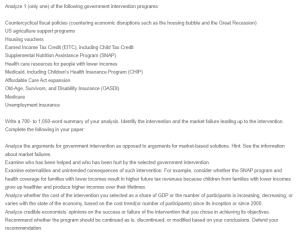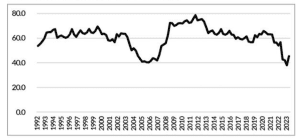Government Intervention Analysis
Government intervention for low-income families is crucial in addressing social and economic issues faced by households with low incomes. The goal of government intervention initiatives is to ensure that low-income families do not fall into extreme poverty. One of the government intervention initiatives is the US government’s housing voucher program, which seeks to address the housing affordability problem. The housing voucher program addresses the homelessness crisis, housing instability, and crowded settlements, among other housing challenges facing low-income individuals and households.
Arguments for Government Intervention
According to Belsky and Wachter (2010), the government intervention in the housing sector is due to the failure of market-based solutions for a long time. The housing crisis in the US has persisted for decades, and the market solutions have failed to cater to the interests of low-income individuals. There are incidents of working individuals who are still unable to afford a home or pay rent. Besides, incidents of people working but still living in their cars are common, due to expensive home prices and high rent. As shown in the Wells Fargo housing opportunity index below, housing prices have been on an upward trajectory since 2000, and in 200,7 when there was a great recession. The increase in home prices does not go parallel with an increase in household incomes, rendering most homes too expensive for the target population.
Figure 1
Housing Opportunity Index (1992 to 2023)
Note. From “The United States Housing Affordability Crisis: No Easy Solutions,” by A. Mallach, 2023, icma.org, (https://icma.org/articles/pm-magazine/united-states-housing-affordability-crisis-no-easy-solutions).
Another argument for government intervention is based on the need to promote equity. One of the factors that has contributed to increasing home prices is gentrification, which pushes people from homes they could previously afford. Instead of pushing these residents out of their residences, the housing voucher program facilitates them to continue living in their current homes (Belsky & Wachter, 2010). For instance, San Francisco emerged as the most gentrified area between 2013 and 2017. Gentrification contributed to a spike in rent, which meant that some residents who could not afford rent had to move to affordable areas. By introducing the housing voucher, the government ensured that people would continue living in their present homes. In the same breath, the increasing interest in mortgages implies that those whose income has not increased proportionally may be unable to afford it. Therefore, the government’s housing voucher program is designed to bridge the gap between high and low-income households, contributing to societal equity.
Losers and Gainers in Government Housing Voucher Programs
The main gainers in the housing voucher program are residents who directly benefit from the program. People who would be homeless, or live in unsuitable living conditions can now afford a home or rental unit, courtesy of the housing voucher program (Turner, 2003). In the same breath, real estate investors and landlords also benefit significantly. The government mostly collaborates with rental unit owners before unveiling a housing deal, saving landlords the work of searching for tenants, not to mention the direct income from the government.
On the other hand, the biggest loser of the housing voucher program is the general public. Property owners are likely to hike home prices or rent once they realize that there is a subsidy-like government intervention (Turner, 2003). Ultimately, members of the public have no option but to incur increased costs due to the government’s subsidy program. Apart from financing the government’s subsidy program as taxpayers, the public will pay for the externalities incurred as a result of the subsidy program.
Externalities and Unintended Consequences of the Government’s Housing Voucher Program
One of the unintended consequences of the housing voucher program is poverty concentration. As the government grants low-income vouchers, it forces them to stay in a specific place. Essentially, the program brings together people who struggle economically in the same location, leading to reduced economic activity in the affected area (Turner, 2003). It is also worth noting that the government constantly monitors the economic status of the beneficiaries such that they may lose their housing once they no longer qualify. Such an action creates a negative incentive to seek opportunities, thereby creating a long-term poverty problem.
According to Semuels (2015), the negative externality characterized by the housing voucher program is the reduction of employment opportunities and earnings. As mentioned above, beneficiaries of the housing voucher program have little motivation to work, aware that the government will pay their bills at the end of the day. In the same breath, the negative incentive of not wanting to lose out on the housing voucher makes others not pursue opportunities that may disqualify them from the beneficiary bracket.
Cost of the Intervention as a Share of GDP
Since its inception in 2000, the housing voucher program has benefited about 10.2 million Americans in 5.2 million households. The cost of the housing program has been on an upward trajectory since its inception. In 2023, the government spent $67 billion on the housing voucher program, representing just over 1% of the total federal outlay (Peterson Foundation, 2024).
Credible Economists’ Opinion on the Housing Voucher Intervention
A great number of economists believe that the housing voucher program is justified based on its economic benefits. The initiative has contributed positively toward alleviating poverty and offering income-generating opportunities for low-income earners. Also, the construction projects emanating from real estate investments have created jobs for more Americans in low-income neighborhoods. For instance, Harvard resident economists, including Raj Chetty, Nathaniel Hendren, and Lawrence Katz, the housing voucher initiative has created better opportunities for low-income households (Sard & Rice, 2016). Some of the benefits include helping beneficiaries’ children access better schools and multi-sectoral job openings.
Recommendations
The housing voucher program should be continued based on its contribution toward poverty alleviation and the creation of new opportunities for low-income households. However, there are a few improvements that should be implemented based on the beneficiaries’ feedback. Relevant government agencies should collaborate with property owners to renovate units under Section 8. Since they are assured of government remittances, some property owners ignore renovating units, leading to deplorable living conditions. Once the government implements a monitoring framework, property owners will take more responsibility to ensure housing units are habitable.
References
Belsky, E. S., & Wachter, S. (2010, February). The need for government intervention to protect and advance the public interest in consumer and mortgage credit markets. In a National Symposium (Vol. 18, pp. 2010-19).
Mallach, A. (2023, December 1). The United States housing affordability Crisis: No easy solutions. icma.org. https://icma.org/articles/pm-magazine/united-states-housing-affordability-crisis-no-easy-solutions
Peterson Foundation. (2024, April 23). The federal government’s support for low-income housing expanded during the pandemic. Www.pgpf.org. https://www.pgpf.org/blog/2024/04/how-does-the-federal-government-support-housing-for-low-income-households#:~:text=April%2023%2C%202024-
Sard, B., & Rice, D. (2016, January 12). Realizing the Housing Voucher Program’s Potential to Enable Families to Move to Better Neighborhoods. Center on Budget and Policy Priorities. https://www.cbpp.org/sites/default/files/atoms/files/11-9-15hous.pdf.
Semuels, A. (2015, June 24). Section 8 is failing poor Americans. The Atlantic; The Atlantic. https://www.theatlantic.com/business/archive/2015/06/section-8-is-failing/396650/
Turner, M. (2003). The Urban Institute, prepared for the Committee on Financial Services, Subcommittee on Housing and Community Opportunity, United States House of Representatives. https://www.urban.org/sites/default/files/publication/64536/900635-Strengths-and-Weaknesses-of-the-Housing-Voucher-Program.pdf
ORDER A PLAGIARISM-FREE PAPER HERE
We’ll write everything from scratch
Question
Analyze 1 (only one) of the following government intervention programs:
Countercyclical fiscal policies (countering economic disruptions such as the housing bubble and the Great Recession)
US agriculture support programs

Government Intervention Analysis
Housing vouchers
Earned Income Tax Credit (EITC), including Child Tax Credit
Supplemental Nutrition Assistance Program (SNAP)
Health care resources for people with lower incomes
Medicaid, including Children’s Health Insurance Program (CHIP)
Affordable Care Act expansion
Old-Age, Survivors, and Disability Insurance (OASDI)
Medicare
Unemployment insurance
Write a 700- to 1,050-word summary of your analysis. Identify the intervention and the market failure leading up to the intervention. Complete the following in your paper:
Analyze the arguments for government intervention as opposed to arguments for market-based solutions. Hint: See the information about market failures.
Examine who has been helped and who has been hurt by the selected government intervention.
Examine externalities and unintended consequences of such intervention. For example, consider whether the SNAP program and health coverage for families with lower incomes result in higher future tax revenues because children from families with lower incomes grow up healthier and produce higher incomes over their lifetimes.
Analyze whether the cost of the intervention you selected as a share of GDP or the number of participants is increasing, decreasing, or varies with the state of the economy, based on the cost trend(or number of participants) since its inception or since 2000.
Analyze credible economists’ opinions on the success or failure of the intervention that you chose in achieving its objectives.
Recommend whether the program should be continued as is, discontinued, or modified based on your conclusions. Defend your recommendation.
Note: Use of charts and graphs is highly encouraged with appropriate citations. Any charts or graphs retrieved from the Federal Reserve Bank of St. Louis FRED website may only be included when the data sources used by FRED are US government sources such as the Bureau of Economic Analysis or the Bureau of Labor Statistics.
Cite at least 4 academically credible sources.
Format your assignment according to APA guidelines.


